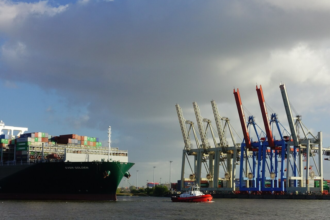As the shockwaves from US President Donald Trump’s tariffs continue to knock around the globe, Asian stock markets have collapsed. On Monday, major market indices ranging from Shanghai to Tokyo, Sydney to Hong Kong, experienced sharp declines; commentators referred to this as “a bloodbath.” The consequences of Trump’s tariff increases—which still influence world trade—are wreaking havoc on the financial markets. Investors are particularly worried about the future due to this turbulence; Asia, which produces a lot of world commodities, is directly under pressure.
Given that Asian nations are among the top exporters in the world, the tariffs especially worry them. From China to Vietnam and Bangladesh, every nation in the area mostly depends on exports to the United States. These days, the new trade policies generate great uncertainty and cause worries about a world trade war. The worries of a recession or even a slowing down in the biggest economy in the world, the United States, have simply heightened the volatility of world markets.
How detrimental was the fall in important Asian markets?
Reflecting the seriousness of the worries about the U.S.-China trade war and the growing tariffs, Monday’s Asian stock market falls were severe. The Nikkei 225 benchmark index for Japan dropped a shockingly 7.8%. The ASX 200 dropped 4.2% in Australia; the Kospi in South Korea closed 5.6% lower. These reductions follow Friday’s notable drops that have also had an impact on world markets.
The delayed reaction to Friday’s declines worsened the stock market slumps in mainland China, Hong Kong, and Taiwan. Public holidays had caused such markets to close, and investors quickly adjusted to the significant losses observed worldwide. The Shanghai Composite Index closed 7.3% lower, while the Taiwan Weighted Index dropped a shockingly 9.7%. The Hang Seng Index sank 12.5% in afternoon trade in Hong Kong.
The general sell-off across these main stock markets underlined the anxiety and uncertainty generated by Trump’s tariffs, which have left investors doubtful about the future course of world economic growth. The notion that these taxes are no little matter is driven home by the ongoing volatility. Should the trade war between the US and China intensify, they could have more general economic effects.
Why are tariffs feeding recession and inflation worries?
The main reason behind the present volatility in the market is the general conviction that tariffs will cause inflation and, finally, a recession. “Tariffs are feeding expectations around inflation and a recession,” said Julia Lee, head of client coverage at FTSE Russell, a London Stock Exchange Group affiliate. Tariffs cause imported items to become more expensive, hence companies are probably going to pass these expenses on customers. This can so produce inflationary pressures all throughout the world.
Rising from a previous estimate of 35%, Goldman Sachs now projects a 45% chance of a US recession over the next 12 months. Following Trump’s tariff move, several big Wall Street companies, such as JPMorgan, have also changed their recession predictions. JPMorgan now projects a 60% likelihood of a US and worldwide recession.
Particularly for Asian nations, a recession in the US would have broad effects. One of the most significant Asian markets for goods, the United States would suffer demand for these exports should its economy slow down. For nations including China, South Korea, and Japan, this would constitute a major obstacle. Particularly susceptible are smaller Asian nations like Vietnam and Bangladesh, which rely mostly on exports to the US.
In what ways are tariffs affecting Asian economies?
Tariffs are seriously hurting the economies of Asian nations. “The US tariff raise is mostly felt in Asia. Although there might be some space for compromise, a new higher tariff government is here to stay, said Qian Wang, chief economist of Asia Pacific at investment company Vanguard. Particularly for smaller, more open economies that depend mostly on trade, these additional tariffs are projected to have a long-lasting detrimental effect on the Asian and worldwide economy.
From Vietnam to Bangladesh, nations greatly depend on the US as a main export destination. Last week, Trump announced tariffs totaling 46% on commodities from Vietnam and 37% on items from Bangladesh. These tariff increases have sparked questions regarding the possible decrease in exports from these nations as well as employment losses in sectors depending on US demand.
Many big US companies, including Nike and Lululemon, manufacture products in Vietnam. Trade statistics from the Bangladesh Garment Manufacturers and Exporters Association show Bangladesh exports over $8.4 billion (£6.5 billion) worth of clothing to the US yearly. Should these products be subject to more taxes, the profitability of these brands may suffer, and exports from Bangladesh and Vietnam to the US could decrease.
The repercussions of the tariffs will probably be seen for years to come as these nations negotiate their implications. Higher tariffs could cause a slowing down in economy, increasing unemployment, and worse standards of life for the people of these nations, several economists caution.
How much of Asia depends on the US for exports?
Frank Lavin, former undersecretary for international trade at the US Department of Commerce, observed, “Asia is likely to feel a disproportionate brunt of this turmoil because Asia sends more exports to the US than to other markets.” For many Asian nations, then, the US’s influence in world trade has grown ever more important.
Slower economic development would follow from a decline in US demand for exports for nations including China, Japan, South Korea, and Taiwan. Smaller economies like Vietnam and Bangladesh, who rely significantly on the US market, are expected to feel the consequences of these tariffs much more strongly, though.
Friday’s global stock market turbulence grew more severe as China responded to Trump’s tariff announcement. Already turbulent, the US stock market suffered additional declines; all three of the main US stock indices dropped by more than 5%. The S&P 500 fell about 6%, the worst week the US stock market has seen since 2020. With Alan’s 5% decline, the FTSE 100 fell the most in five years in the UK. Exchanges in Germany and France likewise suffered comparable falls.
Trade flows, investment, and company confidence may all suffer greatly from the more general economic slowdown brought about by the tariffs and counteractions. As the effects of these tariffs become more apparent, nations throughout Asia are attentively observing the state of affairs.
Looking ahead, what is the outlook for world markets?
The worldwide stock market meltdown seems certain to last. Julia Lee pointed out, “US futures trading lower point to another hard session on Wall Street tonight.” Since Trump promised broad new 10% import levies on goods from every nation, global financial markets have already lost trillions of dollars in value. Products from dozens of nations—including important trading partners China, the European Union, and Vietnam—are now subject to substantially higher tariffs.
The global economy is still being rocked by tariffs, hence, the future of the US and Asian markets is yet unknown. Although the tariffs may be meant to safeguard home businesses, they are seriously upsetting world commerce and financial stability. Over the next months, the whole effect of these developments will show itself as analysts keep close to see how the US and Asia negotiate this difficult economic situation.
Given the major hazards that tariffs create, world leaders will probably have to figure out how to lower tensions and bring stability back into the world economy. But until that occurs, the volatility and uncertainty around the tariffs will probably still resonate across the global financial system, having long-lasting effects on both developed and emerging economies equally.








